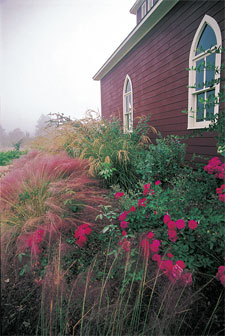Rose Cuttings – June, 2009
In the Company of Roses

The rich red roses of ‘Eutin’ and the hazy pink autumn seed heads of Gulf Coast muhly take center stage in this landscape. Photo courtesy of Mike Shoup.
Hybrid tea roses, bred for showy flowers and often grown for exhibition, do not demonstrate much tolerance for companion plantings. They are often planted in straight rows like erect soldiers posting for inspection. They have been bred to look the same. Old roses, on the other hand, have a diversity of form that lends them very well to the garden where underplantings of perennials, annuals, and existing shrubs are desired. The rose is not required to be the sole provider of color, fragrance and form when used in this manner. It becomes just one of the several varieties of plants in the overall palette that the gardener uses to create his garden masterpiece. The result: when the roses are in bloom, the garden is beautiful, but even when they are not in bloom, the garden is still beautiful. A diversity of plants in a garden scheme ensures continuity of beauty over time and reduces the burden on any one plant to be perfect at all times.
The herb garden was probably the first such garden to house roses. R. gallica officinalis, the ‘Apothecary Rose’, was a companion to fragrant herbs within the enclosed walls of medieval monastery gardens. Roses, like the herbs, were used for medicinal purposes. Attar of roses, rose water, and essences distilled from herbs, were used to treat ailments of the body. Today’s integrated herb gardens are a perfect blend of beauty and function. Herbs can ward off insects and provide contrasts of texture and color for the roses.
Like herbs, grasses comprise a group of plants that also stage roses in a unique way. Ornamental grasses come in many colors, to be combined with roses of all hues, and their graceful linear growth habit can be tufted, mounded, arching or upright. This offers a refreshing contrast to the more rounded shapes of rose bushes and their globular flowers. A favorite combination of mine is miscanthus “Morning Light”, with her silvery leaves, or Gulf Coast muhly (Muhlenbergia capillaries) paired with dark red roses like ‘Louis Philippe’, ‘Eutin’ or ‘Cadenza’.
Cottage gardens and perennial borders, along with theme gardens like a children’s garden or a rock garden, can all utilize roses with various companions, interpreting the gardener’s particular theme. The rhythmic repetition of ornamental grasses and roses in a border, roses embellished with yard art in a children’s garden, or native xeriscape plants mixed with wild roses in a rock garden are all examples of different interpretations a gardener may choose.
About the author: Mike Shoup is the owner of the Antique Rose Emporium. Visit their Brenham and San Antonio display gardens for endless ideas on landscaping with roses. To order roses online, visit www.weAREroses.com.

